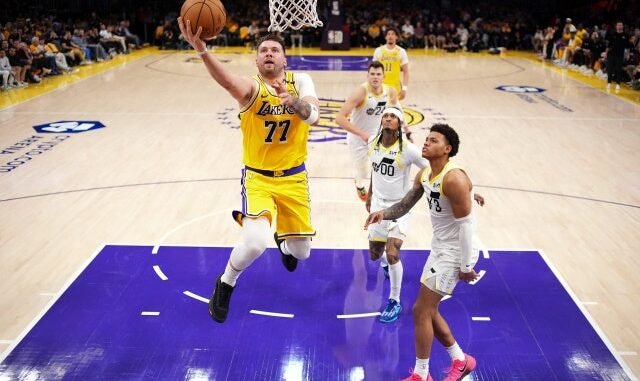
Confirmed deal : The Tragedy and Farce of Luka Dončić’s Trade
There have been worse trades than the one that sent Luka Dončić from the Dallas Mavericks to the Los Angeles Lakers in exchange for Anthony Davis, along with Max Christie and a future first-round draft pick. Here’s one: in 1919, Harry Frazee, the owner of the Boston Red Sox, sold Babe Ruth to the New York Yankees, for a hundred thousand dollars. Frazee had his reasons. For starters, Ruth was a selfish bum. As Glenn Stout wrote in his book “The Selling of the Babe,” “Finding Ruth after a bender—usually sleeping it off somewhere, often in the back alley behind a brothel, his pockets turned inside out—became something of a pastime for his teammates.” Ruth skipped games when he felt like it, and had a habit of gambling away his paychecks. The team tolerated his bad behavior for a while, and not only because he was charming. As a young pitcher, he won sixty-seven games in his first three seasons and set a scoreless-innings record during the 1918 World Series. Plus, he could hit. With his uppercut swing, a rarity at the time, he delighted fans by smashing home runs, though his teammates, who looked to slap the ball for singles instead of walloping it out of the park, thought his technique was suspect. But Ruth wanted to focus on hitting; the Red Sox wanted him to pitch. Ruth knew how to torment the team to get what he wanted, and, anyway, Frazee, who was also a theatre producer, was broke. So he shipped Ruth to the Yankees, who’d never won a playoff series. Legend has it that Frazee used the money to put on the 1925 Broadway musical “No, No, Nanette.”
Ruth went on to lead the Yankees to seven World Series appearances and four championship titles, launching one of the greatest dynasties in the history of sports. The Red Sox, who brought home their fifth title, with Ruth, in 1918, didn’t win another championship until 2004—so strong was the Curse of the Bambino. Never mind the truth behind the Red Sox’s failures (poor decisions by management, and the profound racism of a subsequent owner, Tom Yawkey, who resisted integrating the team). Even the accuracy of the facts is mostly irrelevant. (Frazee was trying to fund the play “My Lady Friends,” on which “No, No, Nanette” was later based.) The trade changed Boston’s sense of its trajectory, even its sense of its identity. What mattered was the story.
Dončić isn’t Ruth, and Davis, a ten-time All-Star, isn’t Nanette. But what matters is the story, and it’s hard to see, for Dallas, how this story has a happy end.
When news of the trade broke, late at night on Saturday, February 1st, disgruntled Mavericks fans gathered outside the team’s stadium in downtown Dallas. They congregated near the twenty-four-foot statue of Dirk Nowitzki, the Mavericks legend who spent twenty-one years with the team. A plaque on the statue, which was erected two years ago, reads “loyalty never fades away.” The next day, workmen power-washed obscenities that had been graffitied on the ground near the statue’s pedestal. A GoFundMe raised tens of thousands of dollars to install billboards calling for the team’s general manager, Nico Harrison, to be fired, and for the Adelson family, the gambling magnates who recently bought a controlling stake in the Mavericks, to sell the team. On the night of the Mavericks’ first post-trade home game, hundreds of fans came to protest outside the stadium. There were Dončić jerseys, signs, a makeshift shrine to Dončić, expressions of rage and grief. Somebody brought a casket.
The trade took everyone by surprise. Rob Pelinka, the Lakers’ general manager, said that at first he’d thought Harrison was joking when he proposed it. Even Jason Kidd, the Mavericks’ head coach, wasn’t informed until the deal was as good as done, according to Harrison, who said this at a press conference as Kidd sat next to him, with a vaguely stunned look. When Shams Charania, the ESPN reporter who is the usual conduit for this sort of news, first posted the deal on X, the general assumption was that he’d been hacked. Charania later said that, when he’d initially got word of it, he had assumed the news was fake, too. N.B.A. teams rarely, if ever, traded a player of Dončić’s calibre at that stage in his career. Not many teams would have even had a chance—only a handful of players had ever put up that kind of production at such a young age. Dončić, who is only twenty-five years old, already has more first-team All-N.B.A. selections than other greats of the game, including Nowitzki and Stephen Curry, in a sport where most players don’t enter their prime until their late twenties. He plays with a rare competitive intensity, a taste for big moments, and a disarming, dazzling style. Last June, he’d dragged a middling Mavericks team all the way to the N.B.A. Finals, in a series of heroic performances: orchestrating and improvising, hitting clutch shot after clutch shot. Mavericks fans embraced him as the new Nowitzki, except better. Few players were more fun to watch than Dončić—at least, when he wasn’t moaning to the referees.
Leave a Reply